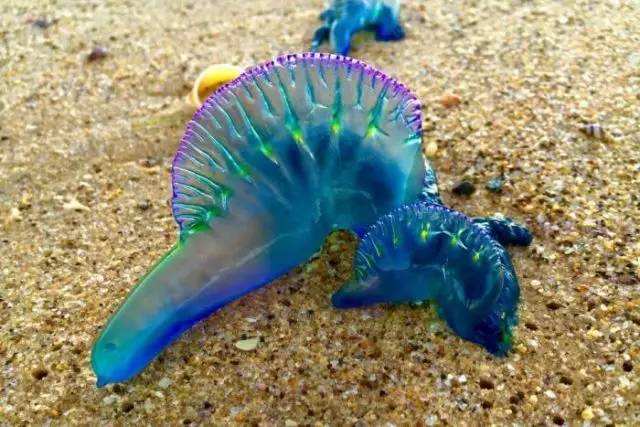
Spring Festival outbound travel, Southeast Asia is the first choice of Chongqing people. However, the recent appearance of a large number of neurotoxin-containing blue bottle monk hat jellyfish on Samira Beach in Songkhla Province, Thailand, has injured 23 citizens and foreign tourists in the country. On the 23rd, the Municipal Tourism Development Commission reminded tourists who have recently gone to Songkhla and Koh Samui to be wary of highly toxic jellyfish.
Chongqing people love to go to Southeast Asia during the Spring Festival
Upstream news reporters learned from the Municipal Tourism Development Commission that during the Spring Festival this year (February 15 to February 21), the inbound and outbound passenger flow of Chongqing Jiangbei International Airport reached more than 74,000 person-times, an increase of 25.72% over last year's Spring Festival. The top three countries in terms of inbound and outbound traffic are: Thailand, Vietnam and Malaysia.
Spending winter on an island with a warm climate and abundant sunshine has become a new trend for Chongqing citizens to celebrate the New Year.
It is reported that during the Spring Festival, Jiangbei Airport added 32 new international route tourism charter flights, flights to Southeast Asia is the largest source of growth, the peak of inbound and outbound passenger flow is concentrated in the morning 23:00-02:00, February 16, 00:00-02:00 two hours, the inbound and outbound passenger flow reached more than 2700 person-times.
Southeast Asian tourism has become a holiday hotspot, on the 23rd, the Chinese Consulate General in Songkhla, Thailand, urgently reminded the public that the citizens of Songkhla and Koh Samui recently went to be wary of highly toxic jellyfish.
Island swimmers should be wary of highly toxic jellyfish
According to the health department of Songkhla Province, Thailand, a large number of blue bottle monk hat jellyfish containing neurotoxins appeared in Samila Beach, Songkhla Province, which has caused injuries to 23 citizens and foreign tourists in the country (one of whom has serious chest and arm injuries and breathing difficulties), and is currently receiving treatment in the local hospital.
The toxin secreted by the monk's hat jellyfish belongs to the neurotoxin, and in addition to severe pain, the injured person will also experience a sudden drop in blood pressure, difficulty breathing, loss of consciousness, general shock, and finally death due to pulmonary circulatory failure.
The Municipal Tourism Commission also specially reminds tourists who have recently traveled to songkhla, Koh Samui and other waters of the Gulf of Thailand to be vigilant, pay attention to personal safety, and pay more attention to coastal signs when swimming or other water activities.
If you encounter jellyfish, do not come into contact with them, and try to keep a distance to avoid unnecessary casualties. Once stung by a monk's hat jellyfish, it is strictly forbidden to rinse or scratch and press the wound with fresh water, and it is necessary to rinse it with acetic acid immediately and go to a nearby hospital for treatment.
If necessary, you can seek assistance from the Consulate General in Songkhla or the Emergency Call Centre of the Global Consular Service of the Ministry of Foreign Affairs.
The news is a little more >>
Stung by a monk hat jellyfish, four-step treatment to keep in mind
Monk's hat jellyfish (Physalia physalis) is a kind of tube jellyfish, floating on the surface of the water pale blue transparent sac-like floating sac, the front end is pointed, the rear end is blunt and round, the tip is raised in the shape of a back peak, the shape is quite similar to the hat of a monk, so it is named monk hat jellyfish.
The killer weapon of the monk hat jellyfish is its tentacles, and the tiny tentacles of the monk hat jellyfish can reach a length of 9 meters, so many swimmers are too late to dodge when they see the monk hat jellyfish.
Once stung by a monk's hat jellyfish, timely rescue is the first priority to survive, rescue steps:
First, in general, after being injured, you should immediately stay away from the sea where the monk hat jellyfish is located, and board the ship or disembark as soon as possible.
Second, remove any visible tentacles from the skin with a clean towel or gloves, and be careful not to treat the wound with empty hands, and be careful not to press the prickly cells further into the skin due to improper handling.
Third, rinse repeatedly with plenty of water or salt water; if the eye is injured, rinse the eye with plenty of mild water for at least 15 minutes, such as blurred vision or persistent tears, pain, swelling or fear of light after irrigation, should be handed over to a doctor.
Fourth, if there is persistent itching or rash, use 1% hydrocortisone ointment four times a day; if possible, soak the affected area in vinegar, which is conducive to washing off the stinging cells.
Experts from the Marine Environment Protection Agency recommend that swimmers in the sea should always be vigilant, because the monk's hat jellyfish are usually bright purple or blue, like floating balloons or ribbons. Children are more vulnerable to attacks by monk-hat jellyfish because the creatures look so beautiful that they tempt people to touch them.
Upstream journalist Xu Ju